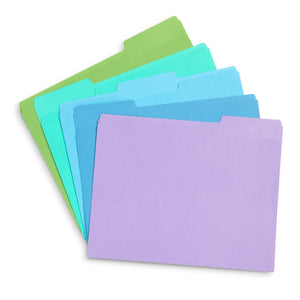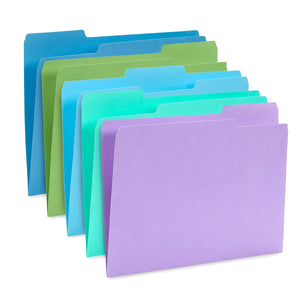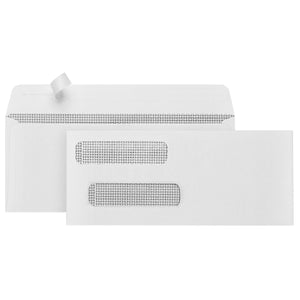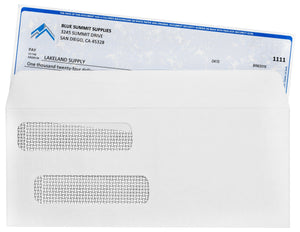What the heck is copy paper vs printer paper? Isn’t there just one kind of printer paper? Unfortunately, there are many, many different types of paper designed for different printers and printing styles.
But don’t worry, you’ve come to the right place. This post will outline the difference between copy paper, printer paper, multipurpose paper, typing paper, laser paper, and coated paper. We’ll also answer some common questions about paper weight, thickness, and brightness.
Types of Paper Stock Compared
Copy Paper vs. Printer Paper
Copy paper is both slightly cheaper and slightly thinner than printer paper. If you only need to print text, you can use either kind. When it comes to printing documents with images, you’ll need to select thicker printer paper, which weighs more. It has to do with the amount of light that passes through each sheet of paper. Copy paper is more transparent than printer paper. Printing documents on copy paper will leave you with saturated, moist-looking images. Sound unappealing? It is!
But as far as printing text or copying documents go, copy paper is an affordable option that will get the job done. Types of copy paper vary in size, with the most common forms being letter (8.5 x 11 inches) and legal (8.5 x 14 inches).
💡Learn more about letter vs. legal size and other paper dimensions.

Copy Paper vs. Multipurpose Paper
Copy paper and multipurpose paper are very similar, though multipurpose paper is brighter than regular copy paper. The multipurpose part means the paper can be used in a variety of ways, from copy machines to fax machines to printers—and, of course, to keep any young office visitors occupied along with a box of crayons. 🖍
Multipurpose paper’s enhanced brightness means it will print slightly crisper images than copy paper. There is also premium multipurpose paper available, which is better quality, but if it’s important that your images be super clear and defined, you’ll want thicker paper.

Typing Paper vs. Printer Paper
Typing paper could refer to paper from a couple of decades ago that was designed for use in an old-fashioned typewriter. You can still buy this type of vintage paper, though whether it actually performs better than ordinary printer paper is a matter of opinion.
If you’re just looking for paper to print typed documents from a computer, regular printer paper is all you’ll need, or you could go slightly cheaper and purchase copy/multipurpose paper.

Laser Paper vs. Copy Paper
Laser paper is made to withstand the heat of a laser printer. Laser printers use toner to produce more vibrant and brilliant images via the printer’s fuser rollers, which fuse the toner to the page with heat. When it comes to laser printer paper vs. copy paper, if you have a laser printer, laser paper will certainly work better, as that is what it’s made for. Copy or multipurpose paper will also work in a laser printer—just don’t expect the images to look as crisp.

Coated vs. Uncoated Paper
Coated paper is coated with a particular finish, either matte, semi-gloss, or glossy, making it typically smooth to the touch with a flat surface. It makes pictures bright and crisp, prevents ink from bleeding, and makes the pages resistant to dirt, moisture, and general wear and tear. Magazines, for example, are printed with coated paper.
Uncoated paper is far more porous, making it rougher than coated paper and more absorbent. You’ll find uncoated paper in novels or the journals and booklets you write in yourself with pencil or pen.

Other Common Questions About Printing Paper Types and Sizes

What is Paper Weight?
Paper weight refers to the weight of the paper you’re using. There are many different kinds of paper, and each has a different weight. Paper is weighted differently depending on how it will be used. For example, paper used to print business cards weighs more than printer paper. You want a business card to be sturdy to present a certain formality and impressiveness, but also to withstand a difficult life spent in somebody else’s wallet.
If someone says paperweight, they may also mean a heavy object used to keep papers on a desk or surface so that they aren’t disturbed or misplaced by a breeze from an open window, a fan, or a coworker walking by your desk too briskly. There are a number of different paperweights on the market, but depending on your needs, you could just use a stapler to hold your paper down. It really depends on the level of geekiness you want to display to your coworkers.

What is Standard Copy Paper Weight?
Paper is weighed in pounds (lbs) and grams per square meter (gsm). It’s a rather complicated way to measure paper, known as basis weight. The most common way you’ll see paper measured is in pounds per 500 sheets (which is a single ream of paper), depending on the specific type of paper. The standard weight of office copy paper is 20 lb. bond. Mysteriously, another common name for this exact same copy paper weight is 50 lb. uncoated text. Both weigh approximately 5 lbs per 500 sheets. They are essentially the same but manufactured with slightly different methods.
Now, you may be wondering, if it says 20 lb. on the package, why does it actually weigh 5 pounds? The manufacturer measures 20 lb. bond paper when it’s sized at 17 x 22 inches weighing 20 lbs, which is roughly 4x the surface area of 8.5 x 11 inches. This works out to 5 lbs for 500 sheets of 8.5 x 11 inch paper. 50 lb. uncoated text is measured with 25 x 38 inch sheets weighing 50 lbs.

WHO KNEW PAPER WAS SO COMPLICATED??
Have a headache yet? Oh, and just for some extra fun, keep in mind that this is only for bond (standard copy) paper. As you’ve probably put together by now, there are many different kinds of paper out there, which means there are many different methods of measuring the many different kinds of paper.

What is the Weight of a Piece of Paper
Generally, a single standard piece of copy paper is 4.5 grams.

What’s the Difference Between Paper Weight vs. Thickness?
You can measure paper by its weight (lb.) or its thickness (pt.), but they generally mean the same thing. The heavier the basic weight of a sheet of paper is, the thicker it will be.

What Does Pt. vs. Lb. Paper Mean?
These are two different ways to measure paper. The point (pt.) measurement refers to the thickness of the paper, whereas the pound (lb.) measurement refers to its weight. Either way, the bigger the number, the thicker and heavier the stock will be.

What’s the Difference Between Text Weight vs. Cover Weight?
Text (also known as book) weight sheets of paper are thin and flexible, like office copy paper or the sheets you’ll find in a magazine. Cover weight sheets (also known as card stock) are thicker and firmer sheets of paper. Both options can come coated or uncoated.

What is Paper Stock?
Most commonly, paper stock refers to the kind of stationery you’re using, such as bond, coated or uncoated, gloss, matte, and so on.
Paper stock could also refer to any of the variety of plants from which the paper is made, such as grass, pine trees, or poplar trees. It may also refer to the fibrous material that’s used to make paper pulp.

What Does Paper Brightness Mean?
Paper brightness is a scientific measurement of how much blue light is reflected from the paper. The more light that’s reflected from the paper, the brighter it is. So, for example, 98 bright will be a brighter white than 92 bright. Brighter paper makes for sharper images and text.

What’s the Difference Between Paper Brightness vs. Whiteness?
Don’t confuse the brightness of a piece of paper with its whiteness. Although you’ll sometimes see these terms used interchangeably, they’re quite different. Paper brightness is a measurement of how much blue light is reflected by the paper, while paper whiteness is a measurement of all the reflected light, which means differences in paper whiteness are a lot easier for our eyes to detect than differences in paper brightness.
More From Blue Summit Supplies
💡 Can I Print 1099 on Plain Paper? And Other Tax Form Questions
We’re passionate about paper and all types of office supplies. Follow our office blog for the latest trends, product comparisons, and more,
If you have any questions or want to talk to someone about office supplies, send us an email or connect with us on Twitter, Facebook, or Instagram.
 For more informative articles about office supplies, subscribe to our email newsletter!
For more informative articles about office supplies, subscribe to our email newsletter!
Never fear, you won't begin receiving daily sales emails that belong in a spam folder. Instead, we promise a fun weekly roundup of our latest blog posts and great finds from across the web. And if you lose interest, it's always easy to unsubscribe with a single click.










